Nader Ghiassi, D.D.S.
admin | Jun 28, 2012 | Comments 0

The Doctor, an outstanding professional, responsible and compassionate, divides his precious time between patients and family, with total commitment, dedication and love, because he knows what is valuable in his life.
Dr. Nader Ghiassi finally arrives to Orange County after a long and difficult journey which had the ability to engrave inside of him, distant countries, unknown languages, multicolored cultures; he admired them and he was enriched throughout this vast experience. Avid for knowledge, he achieved a Bachelor’s degree in science from the University of California, Irvine, UCI, and a doctorate in Dental Surgery from the University of Southern California, USC. Dr. Nader Ghiassi has been an assistant instructor at the USC clinic and has practiced all the areas of dentistry in various clinics. He has been a voluntary dentist at the Pediatric Aid Free Clinic in Santa Ana; an active member of the St. Joseph Community Outreach Program; he has given free dental health assessments to elementary school children and much more. In 2004, he opened a model clinic with advanced technology, Ortega Dental Care, in San Juan Capistrano, to guide, prevent and care for the dental health of his community. Two prominent professionals work with him, Dr. Rasheed Simjee, Professor at USC, and Dr. Ramyar Elyassian, a graduate of USC. Dr. Nader Ghiassi is a man with high ethical and moral values, loves his family, is an exemplary father, he values life and everything in his path. The City is proud of having a professional so efficient, generous and willing to share everything he knows about dental care with the community he loves so much.
“What it is done in the dental field is very important, but so it is having a diagnosis and the appropriate plan before starting treatment. I have seen Dr. Nader Ghiassi’s deep assessments and achieve a clear understanding of what needs to be done before starting the treatment. I have known him for 14 years. I like working in his office, interact with him and provide good dental care to his patients”-Dr. Rasheed Simjee, Professor at USC.
Dr. Nader Ghiassi was born in Tehran, Iran, in a very complex time.
“Iran is divided between a before and an after the revolution; there were many changes, it was a very peculiar time that changed everyone’s life. We were moving from one system to another, and we had a war that lasted 8 years. It was very dangerous, missile attacks all the time, we did not know if any of them would fall on our house at any time”, says Dr. Nader Ghiassi.
How old were you when the revolution started?
Six. Before the revolution I attended U.S. private schools, they were very good, but when the system changed I asked my parents to send me to a public school; there I found another atmosphere, I felt more comfortable, it was more real.
Were there many American schools?
Yes, there were many, and English too. After the 70’s, American schools became more popular.

What was you liked the most in public schools?
The children, the teachers; I felt more comfortable, no one was better than the other. At private schools my classmates’ parents were senators, congressmen, I didn’t feel any connection with them. On the other hand, when I went to public school, I was surprised to discover that some of the boys in 3rd or 4th grade were working after school. I could not believe it!, they studied and worked at the same time, and I began to think that maybe I should do something more than just study. Teachers were different, perhaps one did not learn as much as in other schools, although I always managed to study by myself.
How old were you when you came to this country?
Sixteen. Mom and I left Iran when I was 15, we had to stay one year in Istanbul, a very attractive historical city in Turkey; it was interesting to learn about other cultures, very different from the Iranian. It was a pity that I could not go to school because I did not know the language, but everything I saw captivated me. I learned somehow their culture and I expanded my mind, one becomes more receptive, more positive; people are very different, even with the same religion there are many sects, and you cannot say, “Mine is true and the others are not”. There are many ideologies and a large Christian population, there are beautiful churches I visited almost all, it was fantastic, it is one of the cities to which I’d love to return. We then moved to Buenos Aires and stayed there for a few months.
We ate lots of meat, very good!, the people were friendly, I have had a beautiful experience in that country, I enjoyed it despite not being able to communicate.
Were your parents trying to find a place to settle?
No, it was decided that it would be in the USA. My uncles had moved to this country in 1960; my father traveled from Iran to here until he decided to settle permanently in 1979.
The family was scheduled to reunite in California shortly but the war had unleashed without piety in Iran, missile strikes trace the sky and the earth constantly. The entire country was convulsed, schools, other entities and the airports were closed, making their trip impossible. At the time, their visas expired so mother and son had no other alternative but moved to Istanbul and then to Buenos Aires, while his father tried to manage from here, the family entry into this country. His father worked from the start as financial consultant to Iranian investors wishing to make transactions here. After eight years of confusion and separation, the family is reunited in the U.S.; Doctor Ghiassi was already 16 years old.
Doctor, your family in Iran, is extensive?
Not so big, I have uncles, aunts, cousins and other relatives. They are not that many, but I visit them at least once a year when we travel there.
How was your adaptation here?
Everything was very different to what I knew. When attending private American schools in Tehran, all subjects were taught in Farsi and English; in public schools only Farsi. I also studied Arabic but for not practicing it I forgot it easily. Those years of English helped me much. Here I attended San Clemente High School, and I lamented they did not offer then advanced courses towards college level.
The doctor continues studies at the University of Irvine, UCI, and achieves his Bachelor’s degree, then continues at the University of Southern California, USC, until graduating as a dentist. He attends more than 200 hours of perfecting studies on orthodontics and dental implants per year, and is a member of the American Orthodontic Society (AOS), and the Orange County Dental Society (OCDS).
When does the desire to be a dentist arise?
When I was a four year-old child. I was going with my mother to the dentist and was observing fascinated how he was working, even when he was doing a root canal. I know this sounds somehow strange, but it is true. I liked observing everything he was doing and seeing his instruments: I was fascinated!

Did you have any uncle or relative in this profession?
They all were doctors or engineers. On my father’s side, the majority were doctors and of that of my mother, engineers. And, when I finished UCI and applied to the odontology school my parents were saying to me terrified: “Odontology? You must attend medical school: it is your destiny! I was insisting that I wanted to do what I liked, what I enjoyed; it took them like three years to accept it.
“When I get up in the morning, I gladly prepare myself to go to my office, and I would like to work seven days a week. Really, I enjoy very much my work. I love it!, every case is different”, he says happily. Dr. Ghiassi found his passion and did not abdicate when his parents insisted that he should pursue another career.
“Nader is a person totally dedicated to his work, to his patients, he is very compassionate. He loves his work, he is very loyal and honest. For him, the patient comes first, he thinks what is best for them as well for his staff. He loves doing orthodontics, in reality everything related to dental care, inserting braces and then seeing the result of his work ‘, says his wife.
Dr. Ghiassi strongly believes in orthodontics. “With orthodontics we can improve a patient’s smile. Straight teeth are easier to brush and use dental floss than crooked teeth. A patient with a normal bite is able to chew and digest the food better and this can be achieved with orthodontics”, says the doctor.
Did you obtain a scholarship to study at USC?
I took a loan, there are many government student loans, this is a blessing in this country, I know they cost a lot but they also help a lot, one can pay them when graduates and begins to work.
The doctor worked tirelessly, at as many medical centers as he could, while studying at UC Irvine Medical Center. He did volunteer work at UC County Hospital overnight on Mondays, from 6 pm to 12 am; in a chiropractic office; at the ER in the Western Medical Center for a year and a half; at UC Irvine Brain Imaging, CT Scans, for three years; at the same time he worked at a dental office in Garden Grove, and in one of ophthalmology.
“I volunteered at Pediatric Aid Free Clinic in Santa Ana for four years, going every Saturday, from 9 to 3, on a regular basis to Santa Ana, Los Angeles or Bakersfield. It was a great experience for me. 75% of the children were marginalized Latinos, they were between 7 and 10 years old, and even when they were given a shot, they looked very happy and grateful, amazing! I am sure this does not happen either in Africa or anywhere else in the third world. Many worked for a year, I went for four, it was very gratifying. Once, 20 volunteers and USC professors went to Bakersfield for a week during the summer. About 400 children were waiting for us. The clinic did not have air conditioning, the professors resolved to cancel and told us that we could stay or return. We all decided to stay, and see us so certain, they did too”, says the doctor.
Were any of these paid jobs?
Only two. But what I much valued was the experience I was gaining and making sure I would choose the career that I liked the most. In any area of the medical field one has to coexist with blood, infections, pain, so it is not how much one knows but how much one is capable of giving to that person who trusts us. Surely it is very important how much is known, but this other aspect is as valuable as the first one.
What value would have a doctor that is brilliant for his knowledge if he does not care for his patients?
In my opinion it is necessary to feel passion for what one does, treating the patient better than how one treats oneself, and the money is not the only reward, but feeling good for doing the best for that patient. My wife mentions to me that when she detects in her patients any illness in its first stage, she feels very good because she knows that surely this person will be able to live many more years. However, these health professions bring sometimes very much stress. My wife Margan, is very responsible and dedicated in her profession as doctor. She works, since she graduated in 2007, at the Memorial Care Medical Group in Mission Viejo, place that earlier was called Bristol Park.
When did you meet your wife? Did you go dancing?
In fact, at the Persian festival that is celebrated in March every year in Irvine’s park. A friend of mine was insisting that I should meet a friend of hers. “She has a personality similar to yours, and a strong religious formation like yours, you should meet her”, she said to me one day. I replied I would do it someday. One day I was in the library studying, I had about four exams on the following day and there she came and said to me: “Stop everything right now!” Forget about studying for a little while!, take a break and come with me to the festival, then return and keep on studying”. She dragged me to the festival. There were about 20,000 people in the park, we began to walk when a friend couple saw me and immediately introduced Margan to me, the friend they so much wanted me to meet. I called her some months after that March of 2000.
She was studying at Western University Health Science in Pomona, to become a doctor, I was very interested and wanted to know more about her.
Margan was attending the second year there and I also was in my second year, it was the right time to connect, but was careful to make sure she was available and with no boyfriend. When I graduated and started working, I called and told her that I wanted to know her more; she is very traditional and answered “no” at the beginning, but then asked me to meet her parents first, it was 2002. We got married on May 1, 2004. The reception was at the Irvine Marriott Hotel, very beautiful but that was one of the most overwhelming days of my life. I took care of all the preparations, I made sure that everything went well, and that the food was perfect. Even the interaction with the family of the bride was very cordial and amicable.
But something awkward happened. The person in charge of taking pictures left the room to change the roll, and returned desperate saying that the camera had disappeared. All the pictures in the camera were lost, so they had to take others a month later at a photo studio in Glendale.
When was your first daughter born?
On Thanksgiving Day, in 2005. Her name is Nazanin and she is six; in 2007 Shadee is born, she is five, and the little one Mahtab, in 2010, soon she will be two.
How did you manage with the girls? You, a dentist, and your wife a doctor!
After getting married, she has to complete her residency, with much luck she was accepted at UC Irvine. She had an excellent program that began in 2004 and our first daughter was born in 2005. I looked after Nazanin at night, it was very difficult, much work; the second girl, Shadee, also came during her medical residency. It was a challenge, hard work but well rewarded. Nazanin just finished Kindergarten and will enter first grade this year, and Shadee to Kindergarten.
In which language do you speak to them?
In Farsi and English. We try to teach them words in Farsi, the nanny speaks Spanish so they also understand that language.
Why do you open your clinic in San Juan Capistrano?
I used to live in Capistrano Beach, and I have always studied in San Juan library. San Juan has that peace that cannot be described, it is different from other cities. I have considered other cities, from Los Angeles, Murietta, to Fresno, and I know that in other places you can make much more money because there is not as much competition but I would rather be where I am happy, and there is something about San Juan, people are friendly, they care, they are very warm, my patients are very genuine. My family also lives here and they have been my first patients, without their help it would have been impossible to do all that we have done.
When do you open your clinic?
A month before my wedding, on April 13, 2004, it was a very stressful time for me, because I opened my dental office and I got married at the same time. After the wedding, I told my wife I had not thought where we would go to live. She was shocked and said, “Wait a moment!, you have planned everything except where we would go to live?”
I was paying the mortgage on the office and all the equipment, so I asked Margan to accept living at my parents’ house for some time until we could rent an apartment. We lived there for almost seven months. My parents travel a lot, they regularly spent half a year in Iran, so we were practically alone all this time.
Doctor! You make plans for everything, I cannot believe you had not considered this!
No, I missed it, I was so immersed, overwhelmed with the wedding, with the catering, with the guests, with the hotel. But in the end, all worked out very well because I saved money, and I made the initial payment for our own home. My wife was very condescending, sacrificed their first months of marriage but in the end we both benefited immensely.
Doctor, I am glad to learn you have two associates in your office now.
Yes, Dr. Rasheed Simjee, periodontist, he worked with me when I opened the office in 2004-2005, he was my professor at USC, and he is back now, he takes care of all the complicated cases such as gum surgery, dental implants and other cases. I also have another professional, the periodontist Ramyar Elyassian D. D. S., likewise graduated from the University of Southern California, USC, who has extensive experience in his area. My cousin and childhood friend, Farshid, is the office manager from a few years ago.
In addition, Dr. Ghiassi, with the help of his cousin, is sponsoring two orphanages in Iran, one in Bam with 29 children, place where years ago there was a devastating earthquake, and the other in Tehran, much larger and with more children. “This is a group effort, my uncle is helping us from there and this is only the beginning, we have other future projects”, he says satisfied.
Do you have other plans doctor?
I just hope the practice at San Juan Capistrano continues having many patients to take good care of them, and also to enjoy my family, stay close to my daughters and see them grow up. If one gets too involved in other things we may lose the opportunity to share valuable moments with the family. I thank God for everything that I have and always see my glass almost full instead of almost empty.
What is your opinion about the Latino community?
I start with my staff that has been with me for some time, Lucy, Sandra, Teresa and Silvia, it has been a pleasure working with all of them. They are honest people, we are like a family. Silvia is starting to study dentistry and surely will come back after graduating. I spend more time with them than in my house, and I appreciate that they facilitate me things making everything flow smoothly. They do appreciate the way I treat them. The rule at the office is to say, “Please” to all, either an assistant, a doctor or a patient. No one should feel obliged to be there or follow instructions without asking please and feeling comfortable. The Latino community appreciates when one is genuine, they are very grateful and recommend us to family and friends. We have grown based on the trust of our patients, we have patients coming from Santa Barbara. Almost all of my staff is Latino, I only have a Persian technician, an assistant, my cousin and I. We have formed a very strong family. In these eight years I have not fired anyone, he who left did so by choice.
The doctor promised since he graduated, to see every patient that walks into his office. If someone comes in pain, he has never ceased to tend to him, no matter if he has an HMO, a PPO, cash, or without money. If he has to stay in the office until 8 pm, whether he is by himself or not, he never lets anyone without assistance. The first patient he had was a woman who came after 4 pm on a Saturday, he was closing the office and she asked him to please see her because she had a painful toothache. He then learned she was a coordinator at Mission Hospital. She is still his patient and she has been sending patients to him eversince. He never says no, even when alone in the office or on Sundays.
Doctor, what is the percentage of Latino patients you have?
Around 50 or 60 percent. After these years, I have learned that many make an appointment at three in the afternoon and show up at five. But, we do not lose the hope that they will eventually learn to be punctual.
“It is our duty as health professionals to create awareness of prevention in our patients and communities. Prevention is less costly and less uncomfortable. As a result of the gum disease, patients lose part of the jaw bone and this leads them to lose teeth. Not to chew properly, and not be able to absorb nutrients from everyday food, has resulted in the weakening of the immune system and common diseases,” affirms Dr. Nader Ghiassi.
Filed Under: Outstanding Person • The latest
About the Author:





